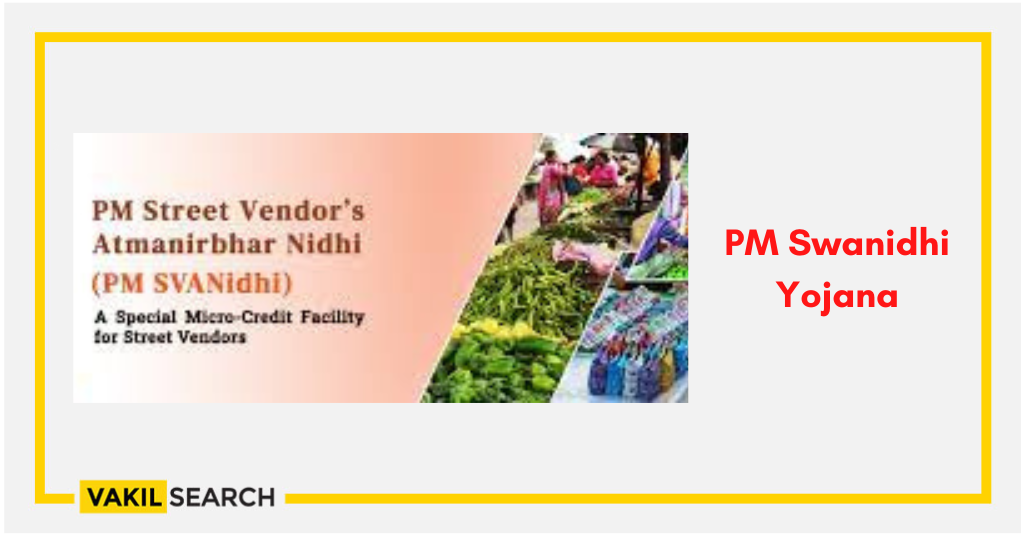In this article, you will be able to find all the information related to the PM Swanidhi Yojana like the application process, eligibility, documents etc.
The central government will grant a loan of up to Rs 10,000 to the country’s street vendors and street vendors (small street vendors) to help them establish their own businesses. Pradhan Mantri Street Vendors Atma Nirbhar Nidhi is another name for this Swanidhi scheme. The benefits of this scheme will be available to all of the country’s small street vendors.
PM Swanidhi Yojana: An Overview
Under the SVANidhi Yojana, street vendors on rural and urban roads in the country who sell fruits and vegetables or set up small shops on the street can get a loan of ₹10,000 from the government. People will have to return in installments over the course of a year. The government will deposit a 7% annual interest subsidy into the accounts of street vendors who repay this loan on time. The country’s interested beneficiaries who want to take advantage of this scheme must apply under this scheme. More than 50 lakh people will benefit from the Street Vendor Self-Reliant Fund, including vendors, hawkers, cart vendors, street vendors, fruit vendors, and others.
PM SVANidhi Scheme
Many vendors, faced severe financial strain during the lockdown period. The PM SVANidhi (Pradhan Mantri Street Vendor’s AtmaNirbhar Nidhi) Scheme was introduced to mitigate the adverse effects of COVID-19 lockdowns on these street vendors.
Objectives Of PM Svanidhi Scheme
The objectives of the PM SVANidhi Scheme are as follows:
- To provide working capital loans of up to Rs. 10,000 at subsidized interest rates.
- To encourage regular repayment of the loan.
- To incentivize digital transactions.
Eligibility Criteria Of PM Svanidhi Scheme
The PM SVANidhi scheme is open to all street vendors in urban areas who were active on or before March 24, 2020. Beneficiaries are identified based on the following criteria:
- Street vendors with an Identity Card or Certificate of Vending issued by Urban Local Bodies (ULBs).
- Street vendors identified in surveys who have not received a Certificate of Vending or Identity Card. In such cases, a Provisional Certificate of Vending is generated.
- Street vendors left out of ULB-led identification surveys or those who started vending after the survey but have received a Letter of Recommendation (LoR) from the ULB or Town Vending Committee (TVC).
- Street vendors from surrounding development, rural, or peri-urban areas vending within the geographical limits of the ULB and holding a LoR from the ULB or TVC.
Benefits Under PM Svanidhi Scheme
Urban street vendors can enjoy the following benefits under the PM SVANidhi scheme:
- Working Capital Loans: Street vendors can secure a Working Capital (WC) loan of up to Rs. 10,000, with a one-year tenure repaid in monthly instalments. No collateral is required, and early repayment makes them eligible for the next cycle of the WC loan with an enhanced limit.
- Rate of Interest: Interest rates vary depending on the lending institution. Scheduled Commercial Banks, Small Finance Banks (SFBs), Regional Rural Banks (RRBs), Cooperative Banks, and SHG Banks apply their existing interest rates. Non-Banking Financial Companies (NBFCs) and Non-Banking Financial Company-Micro Finance Institutions (NBFC-MFIs) follow RBI guidelines for interest rates. Other lender categories not covered by RBI guidelines use interest rates based on the extent of RBI guidelines for NBFC-MFIs.
- Interest Subsidy: Street vendors availing WC loans can receive an interest subsidy of 7%, credited to their account quarterly. This subsidy is available until March 31, 2022, for the first and subsequent enhanced loans.
- Promotion of Digital Transactions: The scheme encourages street vendors to adopt digital transactions through a cash-back facility. Lending institutions and digital payment aggregators like Paytm, BHIM, GooglePay, AmazonPay, BharatPay, PhonePe, etc., help onboard vendors for digital transactions. Onboarded vendors receive monthly cashback incentives ranging from Rs. 50 to Rs. 100.
How to Apply for a Loan Under PM SVANidhi?
Street vendors can apply for loans under the PM SVANidhi scheme through the following steps:
- Approach a Banking Correspondent (BC) or Agent of a Microfinance Institution (MFI) in their area. ULBs maintain a list of these individuals.
- Assist the street vendors in completing the application form and uploading necessary documents through a mobile app or respective portals.
Steps for Online Registration of PM SVANidhi Yojana
The online registration process for the PM SVANidhi Yojana includes the following steps:
- Visit the official website dedicated to the PM SVANidhi scheme.
- Click on the registration link or the designated tab.
- Fill in your personal details, including name, contact information, and other required information.
- Upload necessary documents and submit the application.
What Are the Documents Required for Pradhan Mantri SVANidhi Yojana?
To apply for the Pradhan Mantri SVANidhi Yojana, you will need the following documents:
- Certificate of Vending or ID card issued by ULBs or Letter of Recommendation from ULB or TVC.
- One of the following identification documents:
- Aadhaar card
- Voter Identity card
- Driving license
- MGNREGA card
- PAN card
How to Check the Application Status of PM SVANidhi Yojana?
To check the application status of the PM SVANidhi Yojana, follow these steps:
- Visit the official PM SVANidhi scheme website.
- Navigate to the application status section.
- Select the relevant options and enter your application ID or mobile number, date of birth, and captcha code.
- Click on the submit button to view your application status.
What Are the Guidelines to Follow Before PM SVANidhi Registration?
Before registering for the PM SVANidhi scheme, it’s important to adhere to the following guidelines:
- Ensure that you meet the eligibility criteria, including being an urban street vendor active before March 24, 2020.
- Gather the required documents, such as a Certificate of Vending, ID card, or Letter of Recommendation.
- Identify a Banking Correspondent (BC) or Agent of a Microfinance Institution (MFI) to assist with the application process.
By following these guidelines and meeting the eligibility criteria, street vendors can successfully register for the PM SVANidhi scheme and access its benefits.
FAQ:
1. Who is the target beneficiary of the PM SVANidhi scheme?
The target beneficiaries of the PM SVANidhi scheme are street vendors who have been vending in urban areas on or before March 24, 2020.
2. What is PM SVANidhi Yojana?
PM SVANidhi Yojana is a central government scheme launched by the Ministry of Housing and Urban Affairs to provide working capital loans of up to Rs. 10,000 to street vendors. The scheme aims to assist street vendors in resuming their livelihood
3. Is PM SVANidhi loan interest-free?
No, the PM SVANidhi loan is not interest-free. The interest rate on the loan is low, and an interest subsidy of 7% is provided on timely or early repayment.
4. Who is eligible for PM SVANidhi?
All street vendors engaged in vending in urban areas as on or before March 24, 2020, are eligible for PM SVANidhi. However, the vendors must have a valid vendor ID card, certificate of vending, or a letter of recommendation from the urban local body.
5. What is the limit of PM SVANidhi scheme?
The working capital loan limit of the PM SVANidhi scheme is Rs. 10,000.
Also, Read:










